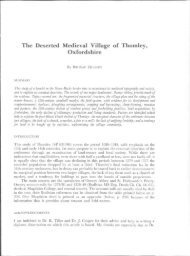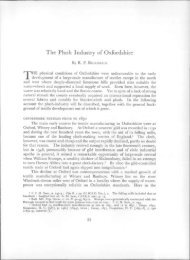Excavations at Wallingford, 1974 - Oxoniensia
Excavations at Wallingford, 1974 - Oxoniensia
Excavations at Wallingford, 1974 - Oxoniensia
You also want an ePaper? Increase the reach of your titles
YUMPU automatically turns print PDFs into web optimized ePapers that Google loves.
EXCAVATIONS AT WALLINGFORD, <strong>1974</strong><br />
Period 3: Burials (thirteenth- fourteenth century A.D.)<br />
Evidence was found of approxim<strong>at</strong>ely 35 inhum<strong>at</strong>ions, all aligned east-west and<br />
nearly all disturbed, usually by l<strong>at</strong>er burials. In trench I, one grave was lined with large<br />
flints, another lined and capped with chalk blocks, the l<strong>at</strong>ter being largely cut away by a<br />
l<strong>at</strong>er pit ( 12 on FIG. 7).<br />
One find , a small bronze buckle, appeared to be associ<strong>at</strong>ed with a burial. It was<br />
found near the left shoulder of an articul<strong>at</strong>ed inhum<strong>at</strong>ion in trench II. No positive d<strong>at</strong>ing<br />
of any of the burials has been made. On the assumption th<strong>at</strong> the graveyard is th<strong>at</strong> of the<br />
church of St. Michael, the burials are probably thirteenth or fourteenth century.<br />
Period 4: Gravel/rubbish pit in trench I (seventeenth century A.D.)<br />
The southern half of trench I was cut through by a large pit, J '5 to 2'0 m. deep into<br />
the n<strong>at</strong>ural gravel ( FIGS. 3 and 7). A general depression in the present ground surface<br />
south of trench I suggests th<strong>at</strong> the pit extends well beyond the southern limit of the trench.<br />
It would seem almost certain th<strong>at</strong> the pit Vvas dug originally to extract gravel. Access<br />
would have been directly from Thames Street.<br />
The various layers in the fill of the pit indic<strong>at</strong>e th<strong>at</strong> it was subsequently used as a<br />
rubbish pit or tip. A number of clay pipe bowls and stems were found in these layers,<br />
some l<strong>at</strong>e seventeenth century in style. This is the only firm d<strong>at</strong>ing evidence found in the<br />
gravel pit.<br />
Period 5: Garden p<strong>at</strong>h and rubbish pit (eighteenth to twentieth century A.D.)<br />
There was a rubbish pit which cut through a burial in trench II, and a gravel surfaced<br />
garden p<strong>at</strong>h passing through both trenches. The p<strong>at</strong>h is shown in the Ordnance Survey of<br />
1877. The rubbish pit, approxim<strong>at</strong>ely I m. square and J m. deep, contained about go Kg.<br />
of glass and china. A small gold ring (probably an ear-ring) hall-marked Birmingham<br />
early twentieth century, was found <strong>at</strong> the very bottom of the pit.<br />
2 I I<br />
CONCLUSIONS<br />
Limited activity on the site before its use for burials is shown by the two pits<br />
in trench I, and the mortar/flint layer in trench II. The pits were apparently not<br />
filled with rubbish, and are therefore comparable to the tenth/eleventh-century<br />
fe<strong>at</strong>ures excav<strong>at</strong>ed recently <strong>at</strong> another of King Alfred's' de novo' burhs, Wareham,<br />
Dorset.' It is not to be expected th<strong>at</strong> intense occup<strong>at</strong>ion would be found so far<br />
from the main street in the first stages of the town's history.<br />
The site presumably already belonged to a church when the large pit was dug<br />
to cast the bell (or bells). Thereafter it was a graveyard, probably to serve St.<br />
Michael's nearby, <strong>at</strong> least until th<strong>at</strong> church was amalgam<strong>at</strong>ed with St. Peter's in<br />
1374. It may have been memories of its use as hallowed ground th<strong>at</strong> restricted its<br />
subsequent development, or it may simply be th<strong>at</strong> its l<strong>at</strong>er history was typical of<br />
<strong>Wallingford</strong>'s physical decay.<br />
THE FINDS<br />
THE PO'ITERY. By R. DIXON, 1. GARDINER, and T. J. WEARE ( FIGS. 8, 9)<br />
Trench II presented the most clearly str<strong>at</strong>ified m<strong>at</strong>erial with a rel<strong>at</strong>ively undisturbed<br />
burial phase (period 3) and the backfill of the bell pit (period 2) yielding approxim<strong>at</strong>ely<br />
350 sherds each. The pottery recovered from trench I will not be discussed here; a<br />
9 Ex. inf. the Editor. To be published in Proc. Dorstt N.H. and A.S. , XCIX ( 1977) .













